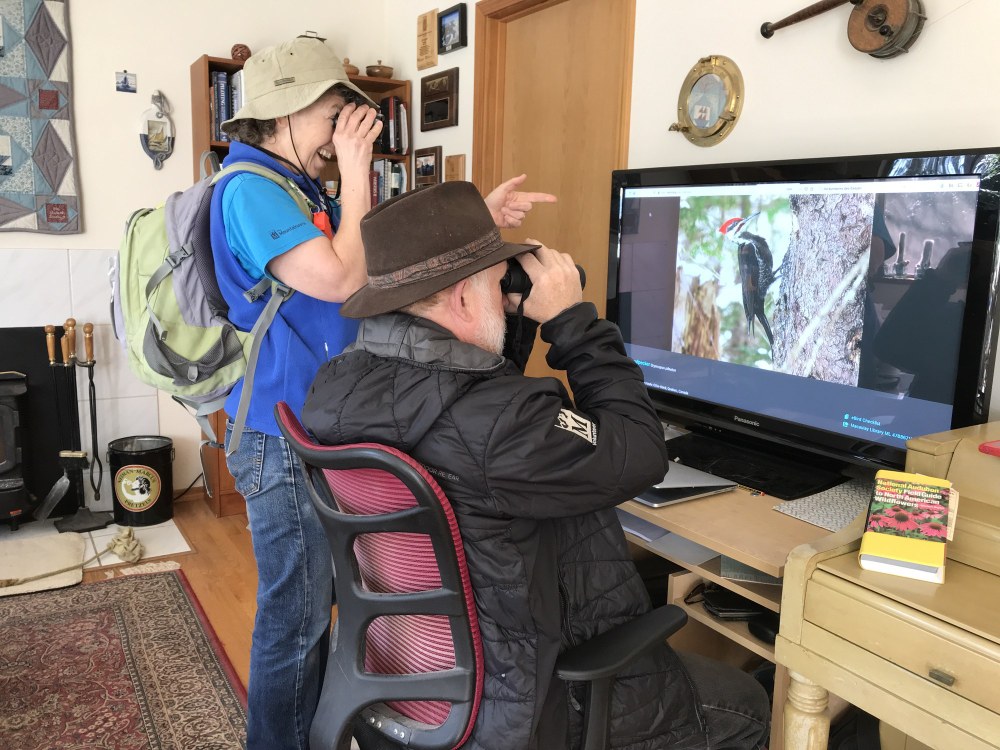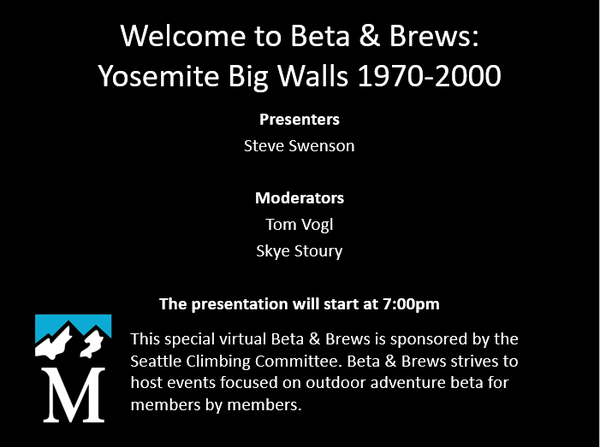
As our community adapts to a new way of gathering together and learning, we're collecting ideas, tips, and how-to's to help you be successful. The Mountaineers community of staff and volunteers has stepped-up to share success stories and answer frequently asked questions about how to make your next virtual event run smoothly.
We will continue to build out these resources as we improve our virtual event offering and find the best ways to stay connected with our outdoor community. Not sure where to start for your first event, or have a question about how to run your presentation more smoothly? Below is a quick list of some best practices for any volunteers thinking about hosting large online events.
Pre-show Preparations
As with in-person events, the large majority of virtual event successes come from preparations prior to the meeting even starting. As the host or event organizer, make sure you’ve done at least the following leading up to the event start. You can also find more specific language to copy and paste into your event listing on our Sample Language & Template page.
- Coordinate with Mountaineers staff to help promote your event. Use the "Virtual" tag to list your program on the Virtual Events & Activities Calendar and email info@mountaineers to have your event shared on Mountaineers social media.
- Decide if you want to charge for your event. Leaders can add a fee to clinics and seminars on our website, or they may direct registration through Eventbrite to collect a fee for events. If you have questions about the best way to list your paid event, please contact info@mountaineer.org for support.
- Determine your group size based on your event objectives. Many platforms like Zoom have a default capacity of 100 attendees. The Mountaineers has a limited ability to increase the group size to 500 attendees.
- If you’d like to offer your meeting through a Mountaineers Zoom account, send an Online Meeting Request form to schedule your session and ensure you have access to all of the features you need.
- Required advanced registration and send attendees a reminder email ~24hrs before the event begins with instructions about how to join the event. For the security of our members and organization, do not post online meeting links directly on your event listing.
- If you advertise your event on another platform that accepts RSVPs (such as Facebook), be sure to note that folks will need to register on The Mountaineers website to receive the virtual meeting link.
- Let folks know (on the program listing or in an initial email) to check their email junk folder if they haven't received a link to join the virtual meeting. It is not uncommon for large BCC'd message to be directed to spam.
- Coordinate with the presenter and any moderators on an appropriate time to test screen sharing and discuss any last minute details. You may decide to do this days before the event or 30 minutes before the event starts. This largely depends on everyone’s comfort level with the meeting platform.
- If you expect a large number of new virtual event users, invite folks to join the meeting 5-10 minutes early to get acquainted with the platform or controls. Alternately, budget this time into your presentation.
- Create a slideshow presentation that is tailored to an online format.
Welcome and Expectation Slides
For the majority of virtual events, the event moderator or presenters will share a slideshow for some portion of the presentation. Start with a pre-show slide to welcome attendees as they join the event. This primarily lets attendees know that they have connected and joined the right event, but it also is a good place to help set initial expectations for the event.

This can include the title, moderators, and the goal of the event. Additional slides might have information about basic meeting controls and a suggested donation. Template slides are available on the Sample Language & Template page.
You may also consider adapting your usual presentation slide deck for a virtual format by inserting multiple “Questions?” slides. Use these slides as markers to pause, stop sharing the presentation, and have a bit of Q&A or discussion with the group. This could also be a good place to incorporate any relevant demonstrations.
Meeting Expectations for Attendees
During the beginning of each presentation, presenters should go over guidelines for what to expect during the event and how attendees should conduct themselves.
- It's a best practice for all attendees to have their video off and audio muted throughout the presentation. This helps cut down on cross-talk, distracting background noise, and saves bandwidth for the presenter's video feed. Asking folks to stay muted is basically the same courtesy as asking people to “mute their cell phones” at the start of an in-person the event. The host or presenter should remind attendees of this during their opening slides.
- As meeting hosts/co-hosts in most platforms, moderators or presenters can mute people who turn on their video/audio to maintain the quality and order of the event. Let folks know you'll be doing this during your intro.
- For a large group event with 15+ attendees, it is most efficient to direct all questions through the platform's chat feature. Presenters may decide to answer questions during their presentation or at the end of the event, just let attendees know at the beginning what to expect. If tracking a chat conversation while presenting is too challenging, you can instead have attendees raise their hands and call on them to ask a question when you're ready.
Need to collect a roster of who attended? Ask folks to make sure the name listed with their meeting logon is something you can cross-reference on your Mountaineers roster. For large groups, first and last name is helpful. In Zoom, attendees can change their name by selecting the Participants box and clicking "Rename" next to their name. Take a screen shot of of the participant list if you need to reference it later!
Interaction during Meetings
There may be some instances, perhaps in small virtual events or online courses, where you want to encourage interaction among participants. Although it's certainly different than in-person events, it's possible and meaningful to build community and get to know new folks online.
- At the beginning of an event, you can ask folks to introduce themselves in the chat. Give everyone guidelines; ask everyone who wants to to write their name and their favorite outdoor activity in the chat, for example. This works well in large groups, as well.
- With Zoom, you can put folks in breakout rooms. You can determine how many people go in a "room" and it creates a smaller setting where people can talk. This can be useful in a course where you want to teach something, like knots. It allows everyone to ask questions. You can pre-determine breakout rooms and create them before a meeting or do it while a meeting is in progress. If you'd like to have leaders screen share within their break out sessions, be sure to assign them as a co-host prior to breaking the groups up.
- Zoom recently released a live transcription feature that allows hosts to automatically provide captions during their meetings. This feature has been enabled for all Mountaineers Zoom licenses. Consider using it to add some easy accessibility to your next event!
Moderators
We strongly encourage all events to have a dedicated volunteer moderator. Moderators are generally responsible for, but not limited to, the following items:
- Being the point of contact for any last-minute or technical questions. In your final email confirmation, note that replies should be directed to your moderator and be sure they are copied on your message. That way the presenter can focus on content and not need to worry about checking their email or the chat!
- Helping welcome attendees to the event prior to the presentation start.
- Turning off attendee’s video and muting audio throughout the presentation.
- Tracking questions in the chat room or reading questions to the presenter at the end of the event or designated Q&A times.
- Pro tip! Copy and paste questions in a separate document in the order you receive them. This makes it easy to review questions quickly, as attendees may also use the chat for other discussion.
- Follow-up with post event requests for the presentation recording or slide deck (if the presenter is willing to share).
Additional Resources
Looking for more help and information? We're adding and updating additional tools, content, and advice on the Leader Resources page. If you have something else to add, leave us a comment of email Sara Ramsay.
Add a comment
Log in to add comments.This is great and timed perfectly. I have an event in two weeks and will use as much of this as I can.
 Garrett Arnold
Garrett Arnold